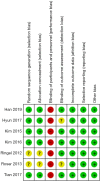Accuracy of robot-assisted versus conventional freehand pedicle screw placement in spine surgery: a systematic review and meta-analysis of randomized controlled trials
- PMID: 32793669
- PMCID: PMC7396236
- DOI: 10.21037/atm-20-1106
Accuracy of robot-assisted versus conventional freehand pedicle screw placement in spine surgery: a systematic review and meta-analysis of randomized controlled trials
Abstract
This systematic review and meta-analysis investigated differences in accuracy, operation time, and radiation exposure time between robot-assisted and freehand techniques for pedicle screw insertion. Two investigators independently searched for articles on randomized controlled trials (RCTs) published from 2012 to 2019. The final meta-analysis included seven RCTs. We compared the accuracy of pedicle screw placement, operation time, and radiation exposure time between robot-assisted and conventional freehand groups. Seven RCTs included 540 patients and placement of 2,476 pedicle screws, of which 1,220 were inserted using the robot-assisted technique and 1,256 were inserted using the conventional freehand technique. The pedicle screw positions were classified using the Gertzbein and Robbins classification (grade A-E). The combined results of Grade A [odds ratio (OR) =1.68; 95% confidence intervals (CI): 0.82-3.44; P=0.16), Grade A+B (OR =1.70; 95% CI: 0.47-6.13; P=0.42), and Grade C+D+E (OR =0.59; 95% CI: 0.16-2.12; P=0.42) for the accuracy rate revealed no significant difference between the two groups. Subgroup analysis results revealed that the TiRobot-assisted technique presented a significantly improved pedicle screw insertion accuracy rate compared with that of the conventional freehand technique, based on Grade A, Grade A+B, and Grade C+D+E classifications. The SpineAssist-assisted technique presented an inferior pedicle screw insertion accuracy rate compared with that of the conventional freehand technique, based on Grade A, Grade A+B, and Grade C+D+E classifications. No difference between the Renaissance-assisted and conventional freehand techniques was noted for pedicle screw insertion accuracy rates, based on both Grade A (OR =1.58; 95% CI: 0.85-2.96; P=0.15), Grade A+B (OR =2.20; 95% CI: 0.39-12.43; P=0.37), and Grade C+D+E (OR =0.45; 95% CI: 0.08-2.56; P=0.37) classifications. Regarding operation time, robot-assisted surgery had significantly longer operation time than conventional freehand surgery. The robot-assisted group had significantly shorter radiation exposure time. Regarding the pedicle screw insertion accuracy rate, the TiRobot-assisted technique was superior, the SpineAssist-assisted technique was inferior, and Renaissance was similar to the conventional freehand technique.
Keywords: Robot-assisted; SpineAssist-assisted technique; TiRobot-assisted technique; radiation exposure; randomized controlled trials (RCTs).
2020 Annals of Translational Medicine. All rights reserved.
Conflict of interest statement
Conflicts of Interest: All authors have completed the ICMJE uniform disclosure form (available at http://dx.doi.org/10.21037/atm-20-1106). The authors have no conflicts of interest to declare.
Figures








Similar articles
-
Accuracy of Pedicle Screw Placement and Clinical Outcomes of Robot-assisted Technique Versus Conventional Freehand Technique in Spine Surgery From Nine Randomized Controlled Trials: A Meta-analysis.Spine (Phila Pa 1976). 2020 Jan 15;45(2):E111-E119. doi: 10.1097/BRS.0000000000003193. Spine (Phila Pa 1976). 2020. PMID: 31404053 Review.
-
Robot-assisted and conventional freehand pedicle screw placement: a systematic review and meta-analysis of randomized controlled trials.Eur Spine J. 2018 Apr;27(4):921-930. doi: 10.1007/s00586-017-5333-y. Epub 2017 Oct 14. Eur Spine J. 2018. PMID: 29032475
-
Accuracy of robot-guided versus freehand fluoroscopy-assisted pedicle screw insertion in thoracolumbar spinal surgery.Neurosurg Focus. 2017 May;42(5):E14. doi: 10.3171/2017.3.FOCUS179. Neurosurg Focus. 2017. PMID: 28463623
-
Robot-assisted technique vs conventional freehand technique in spine surgery: A meta-analysis.Int J Clin Pract. 2021 May;75(5):e13964. doi: 10.1111/ijcp.13964. Epub 2021 Jan 7. Int J Clin Pract. 2021. PMID: 33370470
-
Accuracies of various types of spinal robot in robot-assisted pedicle screw insertion: a Bayesian network meta-analysis.J Orthop Surg Res. 2023 Mar 25;18(1):243. doi: 10.1186/s13018-023-03714-8. J Orthop Surg Res. 2023. PMID: 36966314 Free PMC article.
Cited by
-
Advanced surgical tool: Progress in clinical application of intelligent surgical robot.Smart Med. 2022 Dec 27;1(1):e20220021. doi: 10.1002/SMMD.20220021. eCollection 2022 Dec. Smart Med. 2022. PMID: 39188736 Free PMC article. Review.
-
Pedicle screw placement accuracy in robot-assisted versus image-guided freehand surgery of thoraco-lumbar spine (ROBARTHRODESE): study protocol for a single-centre randomized controlled trial.Trials. 2024 Feb 3;25(1):106. doi: 10.1186/s13063-024-07908-1. Trials. 2024. PMID: 38310274 Free PMC article.
-
Robotics for neuroendovascular intervention: Background and primer.Neuroradiol J. 2022 Feb;35(1):25-35. doi: 10.1177/19714009211034829. Epub 2021 Aug 16. Neuroradiol J. 2022. PMID: 34398721 Free PMC article.
-
Robot-assisted versus fluoroscopy-assisted kyphoplasty in treatment of severe osteoporotic vertebral compression fractures in the old patients: a retrospective study : Robot-assisted in treatment of severe OVCF.BMC Musculoskelet Disord. 2025 Apr 2;26(1):322. doi: 10.1186/s12891-025-08564-5. BMC Musculoskelet Disord. 2025. PMID: 40176005 Free PMC article.
-
Mixed Reality-Based Navigation for Pedicle Screw Placement: A Preliminary Study Using a 3D-Printed Spine Model.Cureus. 2024 Apr 28;16(4):e59240. doi: 10.7759/cureus.59240. eCollection 2024 Apr. Cureus. 2024. PMID: 38813326 Free PMC article.
References
-
- Malhotra D, Kalb S, Rodriguez-Martinez N. Instrumentation of the posterior thoracolumbar spine: from wires to pedicle screws. Neurosurgery 2014;10:497-504. - PubMed
-
- Youkilis AS, Quint DJ, McGillicuddy JE, et al. Stereotactic navigation for placement of pedicle screws in the thoracic spine. Neurosurgery 2001;48:771-8. - PubMed
Publication types
LinkOut - more resources
Full Text Sources
